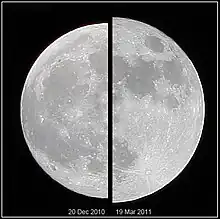英語

2011年3月19日的「超級月亮」(右圖)與2010年12月20日相當「平均大小」的月亮(左圖)的對比
其他形式
詞源
+ 。由占星師Richard Nolle在1979造出。[1]
名詞
(複數)
- (占星術,天文學) 超級月亮
- 反義詞:
- 2014 9月 7, Natalie Angier, “The Moon comes around again [print version: Revisiting a moon that still has secrets to reveal: Supermoon revives interest in its violent origins and hidden face, International New York Times, 10 September 2014, p. 8]”, 出自 :
- And should the moon happen to hit its ever-shifting orbital perigee at the same time that it lies athwart from the sun, we are treated to a so-called supermoon, a full moon that can seem close enough to embrace – as much as 12 percent bigger and 30 percent brighter than the average full moon. […] Some astronomers dislike the whole supermoon hoopla. They point out that the term originated with astrology, not astronomy; that perigee full moons are not all that rare, coming an average of every 13 months; and that their apparently swollen dimensions are often as much a matter of optical illusion and wishful blinking as of relative lunar nearness.
- (請為本引文添加中文翻譯)
近義詞
參見
參考資料
- ↑ Richard Nolle (访问于14 March 2011; no publication date; modified March 10, 2011), “Supermoon”, Astropro:
- SuperMoon is a word I coined in a 1979 article for Dell Publishing Company's HOROSCOPE magazine, describing a new or full moon which occurs with the Moon at or near (within 90% of) its closest approach to Earth in a given orbit (perigee). In short, Earth, Moon and Sun are all in a line, with Moon in its nearest approach to Earth.
This article is issued from Wiktionary. The text is licensed under Creative Commons - Attribution - Sharealike. Additional terms may apply for the media files.